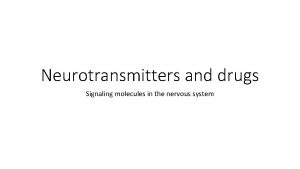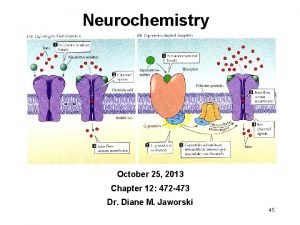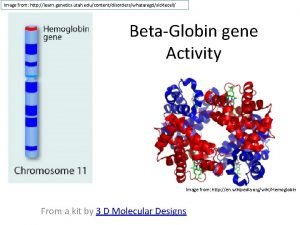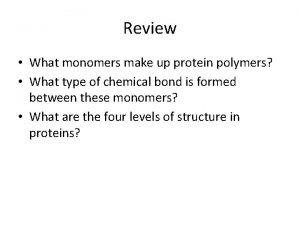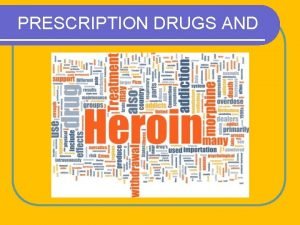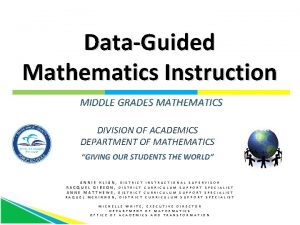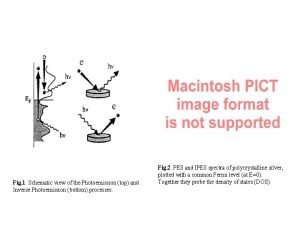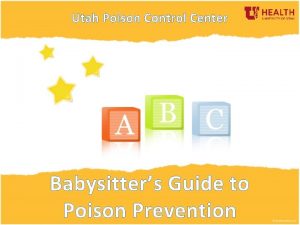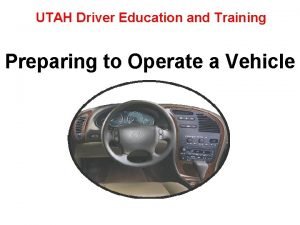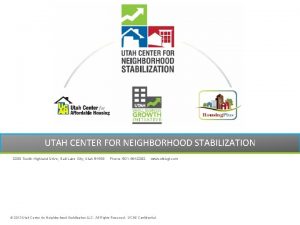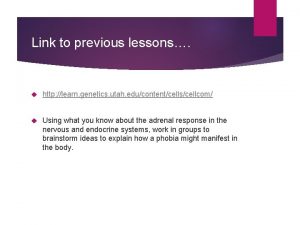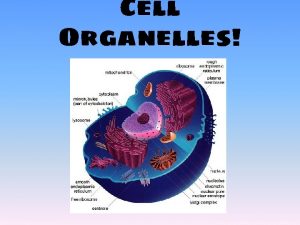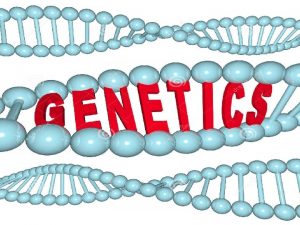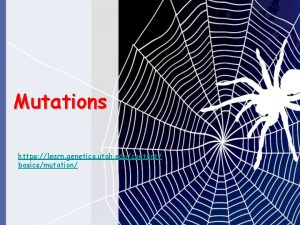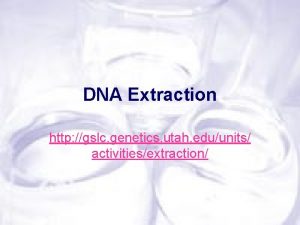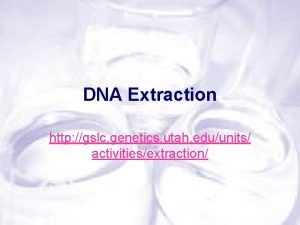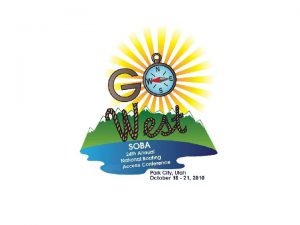Image from http learn genetics utah educontentdisorderswhataregdsicklecell Image




















- Slides: 20

Image from: http: //learn. genetics. utah. edu/content/disorders/whataregd/sicklecell/ Image from: http: //en. wikipedia. org/wiki/Hemoglobin Beta-Globin gene Activity Slide show by Kelly Riedell/Brookings Biology to accompany LAB KIT from 3 D Molecular Designs

LEARNING OBJECTIVE IST-1. K Describe the structures involved in passing hereditary information from one generation to the next. ESSENTIAL KNOWLEDGE IST-1. K. 1 DNA, and in some cases RNA, is the primary source of heritable information. IST-1. K. 2 Genetic information is transmitted from one generation to the next through DNA or RNA— a. Genetic information is stored in and passed to subsequent generations through DNA molecules and, in some cases, RNA molecules. b. Prokaryotic organisms typically have circular chromosomes, while eukaryotic organisms typically have multiple linear chromosomes.

LEARNING OBJECTIVE IST-1. N Describe the mechanisms by which genetic information flows from DNA to RNA to protein. ESSENTIAL KNOWLEDGE IST-1. N. 1 The sequence of the RNA bases, together with the structure of the RNA molecule, determines RNA function— a. m. RNA molecules carry information from DNA to the ribosome. IST-1. N. 2 Genetic information flows from a sequence of nucleotides in DNA to a sequence of bases in an m. RNA molecule to a sequence of amino acids in a protein. IST-1. N. 4 The DNA strand acting as the template strand is also referred to as the noncoding strand, minus strand, or antisense strand. Selection of which DNA strand serves as the template strand depends on the gene being transcribed. IST-1. N. 6 In eukaryotic cells the m. RNA transcript undergoes a series of enzymeregulated modifications— c. Excision of introns and splicing and retention of exons. d. Excision of introns and splicing and retention of exons can generate different versions of the resulting m. RNA molecule; this is known as alternative splicing.

LEARNING OBJECTIVE IST-1. O Explain how the phenotype of an organism is determined by its genotype. IST-1. O. 4 The salient features of translation include— a. Translation is initiated when the r. RNA in the ribosome interacts with the m. RNA at the start codon. b. The sequence of nucleotides on the m. RNA is read in triplets called codons. c. Each codon encodes a specific amino acid, which can be deduced by using a genetic code chart. Many amino acids are encoded by more than one codon LEARNING OBJECTIVE SYI-3. C Explain how chromosomal inheritance generates genetic variation in sexual reproduction. ESSENTIAL KNOWLEDGE SYI-3. C. 3 Certain human genetic disorders can be attributed to the inheritance of a single affected or mutated allele or specific chromosomal changes, such as nondisjunction.

http: //gassama. myweb. uga. edu/hemoglobinmolecule. gif


Amino acid sequence aa Code M= V= amino acid Methionine ____ valine ____ m. RNA codes DNA Codes GUU ____ GUC GUA GUG CAA CAG ______ CAT CAC AUG ____ TAC ______





Sickle Cell disease (anemia) http: //learn. genetics. utah. edu/content/disorders/whataregd/sicklecell/images/sicklecell. jpg

http: //www. ornl. gov/sci/techresources/Human_Genome/posters/chromosome/Gifs/HBBmutseq_2. gif


5 kinds of hemoglobin subunits • • • Alpha (σ) Beta (β) Gamma (ϒ) Delta (δ) Epsilon (ϵ)

Adult hemoglobin σ2 β 2 - 2% of adult hemoglobin = σ2 δ 2 Embryonic hemoglobin σ2 ϵ 2 Fetal Hemoglobin σ2 ϒ 2 • Greater affinity for oxygen than adult hemoglobin • last seven months of development in uterus • in the newborn until roughly 6 months old Sickle cell hemoglobin σ2 β 2 • Mutation in β chain




 Http://learn.genetics.utah.edu/content/addiction/
Http://learn.genetics.utah.edu/content/addiction/ Http://learn.genetics.utah.edu/content/addiction/
Http://learn.genetics.utah.edu/content/addiction/ Www.learn.genetics.utah.edu
Www.learn.genetics.utah.edu What monomers make up protein
What monomers make up protein Learn.genetics.utah/content/addiction/mouse
Learn.genetics.utah/content/addiction/mouse Learn genetics utah karyotype
Learn genetics utah karyotype Tactile learner definition
Tactile learner definition Myadata
Myadata Http//learn.edgenuity.com/student
Http//learn.edgenuity.com/student Http //mbs.meb.gov.tr/ http //www.alantercihleri.com
Http //mbs.meb.gov.tr/ http //www.alantercihleri.com Siat.ung.ac.id krs
Siat.ung.ac.id krs Gestalt leveling
Gestalt leveling Http:/image of fig. 1
Http:/image of fig. 1 Uupm university of utah
Uupm university of utah Utah state animal
Utah state animal Poison control utah
Poison control utah Tracy swena
Tracy swena Utah driver's manual
Utah driver's manual Ddw utah
Ddw utah Utah center for neighborhood stabilization
Utah center for neighborhood stabilization Family facilitator guide utah
Family facilitator guide utah
